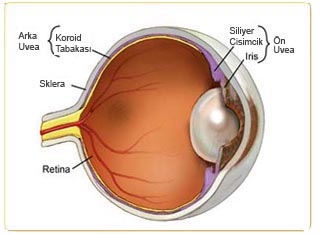Uveitis

Uveitis is an irritation and swelling of uvea which is the middle layer of the coats of the eye. There are also different kinds of uveitis:
When the front part of the uvea (iris and anterior chamber) is swollen or inflamed, it is called iritis or anterior uveitis. Two-thirds to 90% of uveitis cases are anterior in location.
When the middle layer is inflamed, it is called cyclitis.
An inflammation of the back part of the uvea is called choroiditis.
The inflammation of all the layers of the uvea is named pan-uveitis
Uveitis is a serious disease which can scar the eye or lead to blindness. It is estimated to be responsible for approximately 10% of the blindness in the United States. The prognosis is generally good for those who receive prompt diagnosis and treatment. But serious complications including cataracts, glaucoma, band keratopathy, and retinal edema may result at early ages if left untreated.
Early diagnosis and treatment is critical. If your eye is red, painful, and sensitive to light, patient should see a doctor as soon as possible.
The causes of uveitis are not fully understood. Uveitis may also be caused by an allergic reaction or systemic illness such as arthritis or lupus. Eye injuries or multiple eye surgeries can also lead to uveitis. Most often, despite a thorough search, no cause is found. Some causes include some rare infectious diseases.

Uveitis may develop suddenly. You might feel pain in your eye and your eye may become red all over. Or you may not have pain, but your vision suddenly becomes blurry.
Other symptoms of uveitis include light sensitivity and spots in your vision which is named floaters. Any of these symptoms may mean you have uveitis.
A thorough eye examination is necessary to diagnose uveitis. Your ophthalmologist may also order blood tests, skin tests, or x-rays to determine whether you have uveitis or another condition.
Since uveitis can be caused by illnesses in other parts of the body, your doctor will want to know about your overall health. He or she may want to consult with your primary care physician or other specialists.
Treatment aims to reduce inflammation and minimise any potentially sight threatening complications. Primarily, the doctors are interested in protecting the patient’s vision.
Uveitis is typically treated with steroids, either as topical eye drops or oral tablets. Topical cycloplegics may be used not only to lessen the pain and light sensitivity but also to prevent sight threatening complications.
Antimetabolite medications are often used for more aggressive cases of uveitis. Treatment with immunosuppresants such as with cyclosporin may be helpful.
If there is an infection, the aim will be to eliminate that infection. If you are diagnosed with uveitis along with another eye disease like glaucoma or cataract you may also need surgery.



























